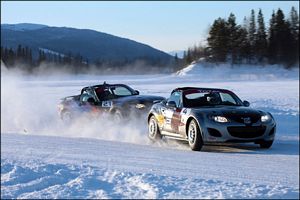|
By accessing or using The Crittenden Automotive Library™/CarsAndRacingStuff.com, you signify your agreement with the Terms of Use on our Legal Information page. Our Privacy Policy is also available there. |

Blue and White Van Man 5 - Motor Sport In Frnace
|
|---|
|
|
Blue and White Van Man 5 - Motor Sport In Frnace
Stan Potter
DriveWrite
November 28, 2013
Stan Potter writes about motor sport in France: Most people are not aware that France is the birthplace of motor sport. Apart from two individuals trying to find who had the faster car, the first ever public race was in 1900 around the roads of Pau in the South West of the country. It was called Le Circuit de Sud Ouest, changed in 1901 to Grand Prix de Sud Ouest. This was the first race to be called a grand prix. From this beginning Motor sport has grown and spread worldwide.
Everybody has heard of the Le Mans 24hr race which started as a street race and many other towns still race around the houses. Local to our house in Poitou Charente the towns of Angouleme and Bressuire both close the town centre and race classic cars, modern cars and open wheel racers around the town streets.
Another famous round the houses event is the Monaco Grand Prix which is as much as much an event for the social calendar as for motor racing enthusiast.
Also the village where our house is hosts the Championship de le Ouest Autocross meeting where drivers from all over western France gather to do battle in tracks marked in the fields near the village. Unfortunately I have not been in Fenioux when these have been in action. As ours is a rural community competitive Tractor Pulling can be found in the locality. Any similarity between these machines and those used on farms for ploughing and cultivation is purely coincidental. In fact these behemoths pull special trailers over an earth track and are powered by engines it is difficult to believe. Aero engines, piston or turbine, are common; also multiple American V8s are the weapon of choice for many. The sound and fury of this sport has to be experienced to be believed. The trailer has a large weight on it and a dozer blade on the front. As the machine moves along the track the weight moves forward on the trailer making forward movement progressively more difficult. The weight is increased until, decided on distance travelled, a winner is found.
Another sport found in the mountainous regions is ice racing. It is circuit racing on tracks bulldozed in the snow on frozen lakes and prepared frozen flooded fields. The cars are very highly tuned small hatchbacks and saloons running narrow tyres with spikes up to 25mm long. They seem to spend most of their time travelling sideways the rear hanging out to remarkable angles.
Drag racing does not seem to have taken off to any extent, probably due to the general resistance to anything originating in the USA. French manufacturers do not now produce large powerful engines. In the past companies such as Facel Vega and Delahaye did, and Bugatti, in their Royale, produced the largest engine ever used in a production car (22 litres). This was also used to power Railcars. Although McDonalds seems to survive in the land of Haut Cuisine, French car manufacturers tend to specialise in the smaller car with engines over 2 litres being rare. The price of fuel may have something to do with this omission from the catalogues. Now, apart from the street and ice racing, there does not appear to be a great difference between our two countries as far as motor sport is concerned.



















